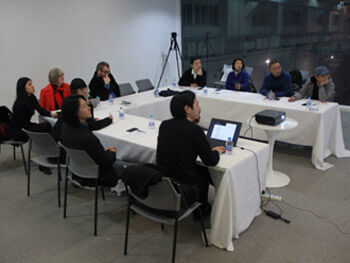Everyday Legend Shanghai Workshop 2016
 EVERYDAY LEGEND SHANGHAI WORKSHOP
EVERYDAY LEGEND SHANGHAI WORKSHOP
VENUE: SHANGHAI MINSHENG ART MUSEUM
DATE: 10 DECEMBER, 2016
After our field trips to Suzhou and Jingdezhen, the project team conducted a workshop at the Minsheng Art Museum in Shanghai, in order to reflect on what we saw and experienced during this trip. Apart from all the project partners, we also invited several local contemporary artists to join us for a roundtable discussion. Each network partner presented four images in their report, to elaborate their after thoughts and reflections through this visual evidence, as well as their relation to the context of contemporary Chinese art.
Sebastian Liang from New Century Art Foundation was the chair of this workshop. Professor Jiang Jiehong first introduced the network project and Leverhulme Trust to all guests. To follow, Professor Oliver Moore, Professor Lv Shengzhong, Nan Nan and Luise Guest all contributed to the visual report. During the open discussion section, some questions were raised, inspired from the field trips to Suzhou and Jingdezhen prior the event. We also invited the Deputy Dierctor of Minsheng Art Museum, Liu Jia and three local contemporary artists, Jin Feng, Yang Zhenzhong and Zhou Xiaohu to join the conversation.
Some of the questions raised by White Rabbit Collection’s Luise Guest are still debatable and have opened up a new space for scholarly inquiry. She asked:
Given the international market for contemporary Chinese art, and the continuing global interest in it, how can Chinese artists navigate a complex field of western expectations of what Chinese art should look like, whilst continuing to reference Chinese tradition and history?
Given the conceptual nature of much contemporary art, what is the role of the materiality of practice, the physical act of making, and how can this project and its associated future exhibitions or publications represent the various positions taken by different artists?
What other forms of traditional practice should the project examine in further research?